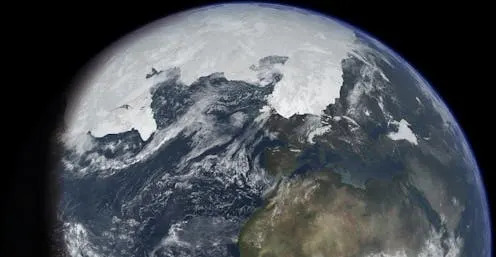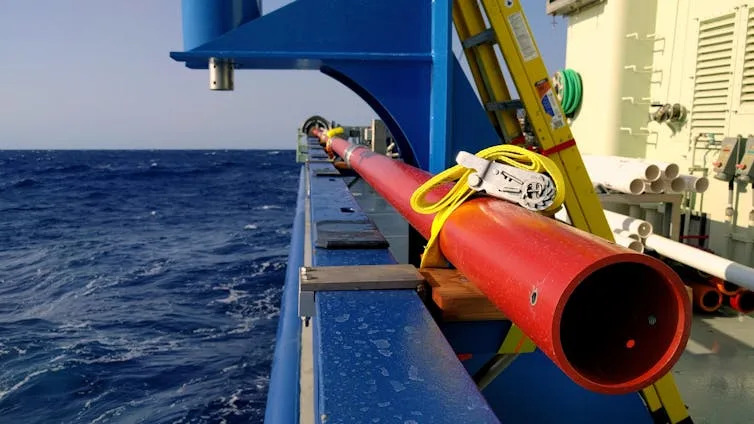The Atlantic Gulf Stream was unexpectedly strong during the last ice age – new study
Mark Maslin, Professor of Natural Sciences, UCL,
Jack Wharton, Postdoctoral Research Fellow in Paleoceanography, UCL,
and David Thornalley, Professor of Ocean and Climate Science, UCL
Wed, 10 July 2024

ittiz/wiki, CC BY-SA
Twenty thousand years ago the world was locked into a great ice age. Ice sheets two miles thick covered much of North America, Scandinavia and the British Isles.
Greenhouse gas concentrations were much lower, the world was 6°C colder, and because of all the water trapped in ice-sheets, the sea was at least 120 metres lower, exposing land that is submerged today. It would have been possible to walk from France to London via Doggerland or from Russia to Alaska through Beringia.
But our research, now published in Nature, has uncovered at least one surprise in the ice age climate: the Gulf Stream, which carries warm water northwards through the Atlantic, was stronger and deeper than it is today.
This research came about because as paleoceanographers (scientists who study oceans in the past), we wanted to understand how the oceans behaved during the last ice age to provide insights into how climate change might alter things in future.
Warm water – from Mexico to Norway
Today, warm salty water from the Gulf of Mexico flows northward as part of the Gulf Stream. As part of it flows past Europe it gives off lots of heat keeping the climate of western Europe very mild.
Then, as the surface water passes north of Iceland, it loses enough heat to increase its density, causing it to sink and form deepwater. This process initiates the global deepwater conveyor belt, which connects all the world’s oceans, slowly moving heat around the planet at depths greater than one mile below the surface.
Scientists previously thought the Atlantic meridional overturning circulation – a complex system of deep and surface ocean currents, including the Gulf Stream – was weaker during extreme cold periods such as the last ice age. In theory, more sea ice in the Arctic would have reduced the amount of water sinking from the surface into the deep ocean, slowing down the global deepwater conveyor belt.
However, our new study reveals that the Gulf Stream was actually much stronger (and deeper) during the last ice age. This is despite the prevailing cold glacial climate and the presence of enormous ice sheets around the northern parts of the Atlantic.
In fact, our research suggests that the glacial climate itself was responsible for driving a stronger Gulf Stream. In particular, the ice age was characterised by much stronger winds over parts of the North Atlantic, which would have driven a stronger Gulf Stream. Therefore, although the amount of water sinking from the surface into the deep ocean was reduced, the Gulf Stream was stronger and still transporting lots of heat northwards, albeit not as far as today.
Scientists previously thought the Atlantic meridional overturning circulation – a complex system of deep and surface ocean currents, including the Gulf Stream – was weaker during extreme cold periods such as the last ice age. In theory, more sea ice in the Arctic would have reduced the amount of water sinking from the surface into the deep ocean, slowing down the global deepwater conveyor belt.
However, our new study reveals that the Gulf Stream was actually much stronger (and deeper) during the last ice age. This is despite the prevailing cold glacial climate and the presence of enormous ice sheets around the northern parts of the Atlantic.
In fact, our research suggests that the glacial climate itself was responsible for driving a stronger Gulf Stream. In particular, the ice age was characterised by much stronger winds over parts of the North Atlantic, which would have driven a stronger Gulf Stream. Therefore, although the amount of water sinking from the surface into the deep ocean was reduced, the Gulf Stream was stronger and still transporting lots of heat northwards, albeit not as far as today.
Reconstructing past ocean circulation
Since we don’t have any data from weather buoys or satellites, we instead reconstructed how the ocean would have circulated in the last ice age using proxy evidence preserved in marine sediment cores, which are long tubes of mud from the bottom of the ocean.
The cores we used contained mud that had been building up on the seafloor for the past 25,000 years and were retrieved from multiple locations along the US east coast using research vessels from Woods Hole Oceanographic Institution in Massachusetts, where some of our team are based.

Red tube on side of ship
To determine the Gulf Stream’s strength during the ice age, we measured the size of sediment grains within the mud, with larger grains indicating faster flow and vice versa.
From the same mud, we also measured the shell chemistry of tiny single-celled organisms called foraminifera. By comparing data from a range of depths at multiple sites in the Northwest Atlantic, we were able to identify the boundary between those foraminifera that once lived in warm subtropical waters and those that lived in colder subpolar waters. This allowed us to determine the depth of the Gulf Stream at the time those organisms were alive.
This adds uncertainty to climate projections
Our research highlights how the Gulf Stream, and the wider system of Atlantic currents, is sensitive to changes in wind strength as well as meltwater from the Greenland ice sheet. This has important implications for future climate change.
Climate models predict the Gulf Stream will weaken over the 21st century, in part due to reduced windiness. This would lead to even higher sea levels along the US east coast and relatively less global warming in Europe. If climate change causes changes in wind patterns in the future, the Gulf Stream will also change, adding to the uncertainty about future climate conditions.
Our results also highlight why we should not make simplistic statements about Atlantic currents and future climate change. The Atlantic features a set of interconnected currents, each with own behaviour and unique response to climate change. Therefore, when explaining the impact of anthropogenic climate change on the climate system, we need to be very clear about which part we are discussing and the specific implications for different countries.
This article is republished from The Conversation under a Creative Commons license. Read the original article.

The Conversation
Jack Wharton receives funding from the Natural Environmental Research Council (NERC) and the European Union's Horizon Europe Project EPOC.
David Thornalley has received grant funding from NERC, NSF, Innovate UK, European Union Horizon 2020 and Horizon Europe programmes, and the Leverhulme Trust.
Mark Maslin is Pro-Vice Provost of the UCL Climate Crisis Grand Challenge. He is co-director of the London NERC Doctoral Training Partnership and a member of the Climate Crisis Advisory Group. He is an advisor to Sheep Included Ltd, Lansons, NetZeroNow and the UK Parliament. He has received grant funding from the NERC, EPSRC, ESRC, DFG, Royal Society, DIFD, BEIS, DECC, FCO, Innovate UK, Carbon Trust, UK Space Agency, European Space Agency, Research England, Wellcome Trust, Leverhulme Trust, CIFF, Sprint2020, and British Council. He has received funding from the BBC, Lancet, Laithwaites, Seventh Generation, Channel 4, JLT Re, WWF, Hermes, CAFOD, HP and Royal Institute of Chartered Surveyors.
No comments:
Post a Comment